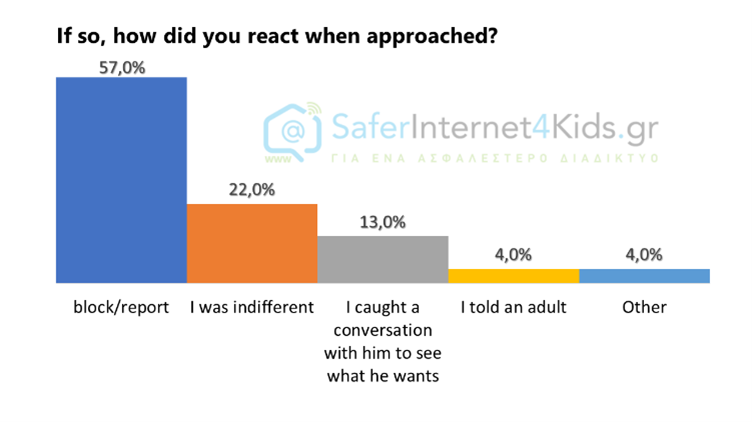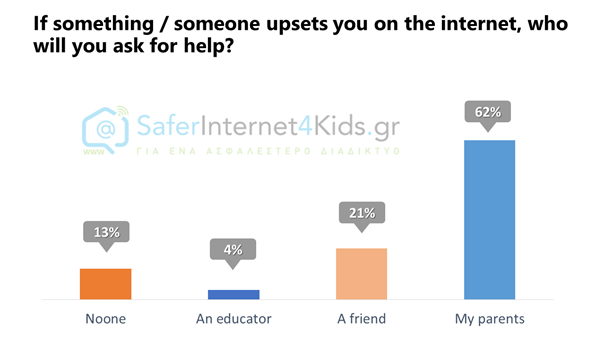One in four children has received personal photos of others and has been harassed online, while one in two chats with strangers and makes friends online. One in four children has encountered hate speech on the internet and one in nine children has fallen victim to cyber fraud. According to the findings of a recent survey in Greece, children and young people do not seem to hesitate to block someone or something that has upset them on the internet, but they do not proceed so easily to make a report.

On the occasion of Safer Internet Day (SID) 2022, which took place on Tuesday, 8 February, the Greek Safer Internet Centre (SIC) of FORTH under the auspices of the Ministry of Education and Religions, revealed the results of recent research regarding the internet habits of children. The study was conducted in November-December 2021 and surveyed 5,000 students aged 12-18 years.

According to the results, the practice of exchanging very personal photos (sexting) is widespread among teenagers as 1 in 4 has received someone else's personal photos, and 6 per cent admit that they have sent personal photos.


This trend, combined with the fact that young people are not very interested in how their online reputation is shaped by what they post on the internet, is worrying. Online reputation does not concern 53 per cent of children, and in addition 23 per cent answered: "I do not know".


Another trend that seems to be gaining ground in recent years is the emergence of hate speech on the internet. 34 per cent of children say they have encountered online hate speech.


Regarding cyberbullying, 6 per cent state that they have been the victim of cyberbullying, with girls outnumbering boys, and 13 per cent have witnessed bullying. Of the children who have noticed a friend/acquaintance being bullied, the encouraging thing is that the majority did not ignore but tried to support the victim privately. Still, only a small percentage turned to an adult.





Despite the fact that children consider the disclosure of personal data and contact with strangers the two biggest dangers on the internet, at the same time, one in two children chat with strangers and make friends online.



One in four children states that, at some point, someone approached them on the internet with malicious intent. Of these, 3 per cent chatted with them to see their intentions.


According to the survey findings, children and young people do not seem to hesitate to block someone or something that has upset them on the internet, but they do not proceed so easily to make a report.



Another point that should be emphasised is that if something happens on the internet, 62 per cent of children will ask for help from their parents, 21 per cent from a friend, and 13 per cent will deal with it alone without asking for help. Only 4 per cent will address the issue to an educator.

Lastly, read the following infographic summarising the survey results. You can also download the infographic here.
Find out more about the work of the Greek Safer Internet Centre, including its awareness raising, helpline, hotline and youth participation services – or find similar information for Safer Internet Centres throughout Europe.
Find out more about the annual global celebration of Safer Internet Day more generally here.
One in four children has received personal photos of others and has been harassed online, while one in two chats with strangers and makes friends online. One in four children has encountered hate speech on the internet and one in nine children has fallen victim to cyber fraud. According to the findings of a recent survey in Greece, children and young people do not seem to hesitate to block someone or something that has upset them on the internet, but they do not proceed so easily to make a report.

On the occasion of Safer Internet Day (SID) 2022, which took place on Tuesday, 8 February, the Greek Safer Internet Centre (SIC) of FORTH under the auspices of the Ministry of Education and Religions, revealed the results of recent research regarding the internet habits of children. The study was conducted in November-December 2021 and surveyed 5,000 students aged 12-18 years.

According to the results, the practice of exchanging very personal photos (sexting) is widespread among teenagers as 1 in 4 has received someone else's personal photos, and 6 per cent admit that they have sent personal photos.


This trend, combined with the fact that young people are not very interested in how their online reputation is shaped by what they post on the internet, is worrying. Online reputation does not concern 53 per cent of children, and in addition 23 per cent answered: "I do not know".


Another trend that seems to be gaining ground in recent years is the emergence of hate speech on the internet. 34 per cent of children say they have encountered online hate speech.


Regarding cyberbullying, 6 per cent state that they have been the victim of cyberbullying, with girls outnumbering boys, and 13 per cent have witnessed bullying. Of the children who have noticed a friend/acquaintance being bullied, the encouraging thing is that the majority did not ignore but tried to support the victim privately. Still, only a small percentage turned to an adult.





Despite the fact that children consider the disclosure of personal data and contact with strangers the two biggest dangers on the internet, at the same time, one in two children chat with strangers and make friends online.



One in four children states that, at some point, someone approached them on the internet with malicious intent. Of these, 3 per cent chatted with them to see their intentions.


According to the survey findings, children and young people do not seem to hesitate to block someone or something that has upset them on the internet, but they do not proceed so easily to make a report.



Another point that should be emphasised is that if something happens on the internet, 62 per cent of children will ask for help from their parents, 21 per cent from a friend, and 13 per cent will deal with it alone without asking for help. Only 4 per cent will address the issue to an educator.

Lastly, read the following infographic summarising the survey results. You can also download the infographic here.
Find out more about the work of the Greek Safer Internet Centre, including its awareness raising, helpline, hotline and youth participation services – or find similar information for Safer Internet Centres throughout Europe.
Find out more about the annual global celebration of Safer Internet Day more generally here.
- Safer Internet Day (SID) digital citizenship
Related content
- < Previous article
- Next article >











